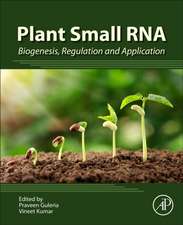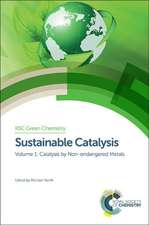Bioremediation for Environmental Sustainability: Toxicity, Mechanisms of Contaminants Degradation, Detoxification and Challenges
Editat de Gaurav Saxena, Vineet Kumar, Maulin P. Shahen Limba Engleză Paperback – 20 oct 2020
This book is a reference for students, researchers, scientists, and professionals in the fields of microbiology, biotechnology, environmental sciences, eco-toxicology, environmental remediation, and waste management, especially those who aspire to work on the biodegradation and bioremediation of industrial wastes and environmental pollutants for environmental sustainability. Environmental safety and sustainability with rapid industrialization is one of the major challenges worldwide. Industries are the key drivers in the world economy, but these are also the major polluters due to discharge of potentially toxic and hazardous wastes containing various organic and inorganic pollutants, which cause environmental pollution and severe toxic effects in living beings.
- Introduces pollution and toxicity profiles of environmental contaminants and industrial wastes, including oil refinery wastewater, distillery wastewater, tannery wastewater, textile wastewater, mine tailing wastes, plastic wastes, and more
- Describes underlying mechanisms of degradation and detoxification of emerging organic and inorganic contaminants with enzymatic roles
- Focuses on recent advances and challenges in bioremediation and phytoremediation, including microbial enzymes, biosurfactants, microalgae, biofilm, archaea, genetically engineered organisms, and more
- Describes how microbes and plants can be successfully applied for the remediation of potentially toxic industrial wastes and chemical pollutants to protect the environment and public health
| Toate formatele și edițiile | Preț | Express |
|---|---|---|
| Paperback (2) | 1049.91 lei 5-7 săpt. | |
| ELSEVIER SCIENCE – 29 aug 2020 | 1049.91 lei 5-7 săpt. | |
| ELSEVIER SCIENCE – 20 oct 2020 | 1054.67 lei 5-7 săpt. |
Preț: 1054.67 lei
Preț vechi: 1375.82 lei
-23% Nou
Puncte Express: 1582
Preț estimativ în valută:
201.85€ • 209.92$ • 168.91£
201.85€ • 209.92$ • 168.91£
Carte tipărită la comandă
Livrare economică 07-21 martie
Preluare comenzi: 021 569.72.76
Specificații
ISBN-13: 9780128205242
ISBN-10: 0128205245
Pagini: 692
Dimensiuni: 191 x 235 x 37 mm
Greutate: 1.17 kg
Editura: ELSEVIER SCIENCE
ISBN-10: 0128205245
Pagini: 692
Dimensiuni: 191 x 235 x 37 mm
Greutate: 1.17 kg
Editura: ELSEVIER SCIENCE
Public țintă
Researchers, Chemical/Environmental Engineers, Environmental Health and Risk Scientists, Environmental Chemists and Scientists, Environmentalists, Microbiologists and Biotechnologists, Waste Treatment EngineersCuprins
Section I. Introduction to Bioremediation1. Bioremediation: Principles and Applications in Environmental Management2. Phytoremediation of Heavy Metals-Contaminated Soils: Recent Advances and Challenges
Section II. Bioremediation of Inorganic Contaminants3. Hexavalent Chromium: Toxicological Profile and Biodetoxification Mechanisms for Bioremediation4. Arsenic Contamination in Environment: Environmental and Health Hazards and Bioremediation Approaches for Detoxification5.Cadmium Contamination in Environment: Environmental and Health Hazards and Bioremediation Strategies6. Phytoremediation of Selenium: Challenges and Future Prospects7. Role of Endophytes in Bioremediation of Heavy Metals: Challenges and Prospects8. Role of Aquatic Macrophytes in Heavy Metals Removal from Industrial Wastewaters
Section III. Bioremediation of Organic Contaminants9. Ecotoxicological and Health Effects of Persistent Organic Pollutants (POPs) and Their Biodegradation and Bioremediation10. Toxicity Profile and Bioremediation Approaches for Polyaromatic Hydrocarbons (PAHs)11. Toxicity Profile and Bioremediation Strategies for Organophosphate Pesticides12. Toxicity Profile and Phytoremediation Approaches for Organic Pollutants: A Review13. Toxicity Profile of Pentacholorophenol and Bioremediation Strategies14. Toxicity Profile of Polychlorinated Biphenyls and Bioremediation Approaches15. Role of Endophytes in Bioremediation of Organic Contaminants: Challenges and Prospects16. Toxicity Profile and Biodegradation of Chlorinated Compounds17. Toxicity Profile and Biodegradation of Nitro-Aromatic Compounds18. Environmental Hazards of Lignocellulosic Waste and Its Biodegradation19. Toxicity Profile and Biodegradation of Hexachlorocyclohexane (HCH)20. Environmental Hazards, Toxicity Profile and Bioremediation Approaches for Azo dyes
Section IV. Bioremediation of Industrial Wastes21. Bioremediation Approaches for Industrial Acid Mine Tailing Wastes: Potential Issues and Prospects22. Environmental Contamination, Toxicity Profile and Bioremediation Approaches for Distillery Effluent23. Environmental Hazards and Biodegradation of Plastic Waste: Challenges and Future Prospects24. Environmental Contamination, Toxicity Profile and Bioremediation Approaches for Textile Effluent25. Environmental Contamination, Toxicity Profile and Bioremediation Approaches for Pulp Paper Industry Effluent26. Toxicity Profile and Bioremediation Approaches for Tannery Wastewater27. Microalgae as Agents for Industrial Effluent Treatment: Opportunities and Challenges28. Applications of Cyanobacteria in Industrial Effluent Treatment: Opportunities and Challenges
Section V. Recent Advances and Challenges in Bioremediation29. Genetically Engineered Microbes in Biodegradation and Bioremediation of Environmental Pollutants: Challenges and Prospects30. Applications of Biosurfactants in Environmental Management: Challenges and Prospects31. Diversity and Applications of Archaea in Bioremediation of Environmental Contaminants32. Microbial Enzymes and Role in Bioremediation of Environmental Pollutants: Prospects and Challenges33. Engineering Aspects and Roles of Biofilm in Bioremediation of Environmental Contaminants
Section II. Bioremediation of Inorganic Contaminants3. Hexavalent Chromium: Toxicological Profile and Biodetoxification Mechanisms for Bioremediation4. Arsenic Contamination in Environment: Environmental and Health Hazards and Bioremediation Approaches for Detoxification5.Cadmium Contamination in Environment: Environmental and Health Hazards and Bioremediation Strategies6. Phytoremediation of Selenium: Challenges and Future Prospects7. Role of Endophytes in Bioremediation of Heavy Metals: Challenges and Prospects8. Role of Aquatic Macrophytes in Heavy Metals Removal from Industrial Wastewaters
Section III. Bioremediation of Organic Contaminants9. Ecotoxicological and Health Effects of Persistent Organic Pollutants (POPs) and Their Biodegradation and Bioremediation10. Toxicity Profile and Bioremediation Approaches for Polyaromatic Hydrocarbons (PAHs)11. Toxicity Profile and Bioremediation Strategies for Organophosphate Pesticides12. Toxicity Profile and Phytoremediation Approaches for Organic Pollutants: A Review13. Toxicity Profile of Pentacholorophenol and Bioremediation Strategies14. Toxicity Profile of Polychlorinated Biphenyls and Bioremediation Approaches15. Role of Endophytes in Bioremediation of Organic Contaminants: Challenges and Prospects16. Toxicity Profile and Biodegradation of Chlorinated Compounds17. Toxicity Profile and Biodegradation of Nitro-Aromatic Compounds18. Environmental Hazards of Lignocellulosic Waste and Its Biodegradation19. Toxicity Profile and Biodegradation of Hexachlorocyclohexane (HCH)20. Environmental Hazards, Toxicity Profile and Bioremediation Approaches for Azo dyes
Section IV. Bioremediation of Industrial Wastes21. Bioremediation Approaches for Industrial Acid Mine Tailing Wastes: Potential Issues and Prospects22. Environmental Contamination, Toxicity Profile and Bioremediation Approaches for Distillery Effluent23. Environmental Hazards and Biodegradation of Plastic Waste: Challenges and Future Prospects24. Environmental Contamination, Toxicity Profile and Bioremediation Approaches for Textile Effluent25. Environmental Contamination, Toxicity Profile and Bioremediation Approaches for Pulp Paper Industry Effluent26. Toxicity Profile and Bioremediation Approaches for Tannery Wastewater27. Microalgae as Agents for Industrial Effluent Treatment: Opportunities and Challenges28. Applications of Cyanobacteria in Industrial Effluent Treatment: Opportunities and Challenges
Section V. Recent Advances and Challenges in Bioremediation29. Genetically Engineered Microbes in Biodegradation and Bioremediation of Environmental Pollutants: Challenges and Prospects30. Applications of Biosurfactants in Environmental Management: Challenges and Prospects31. Diversity and Applications of Archaea in Bioremediation of Environmental Contaminants32. Microbial Enzymes and Role in Bioremediation of Environmental Pollutants: Prospects and Challenges33. Engineering Aspects and Roles of Biofilm in Bioremediation of Environmental Contaminants























